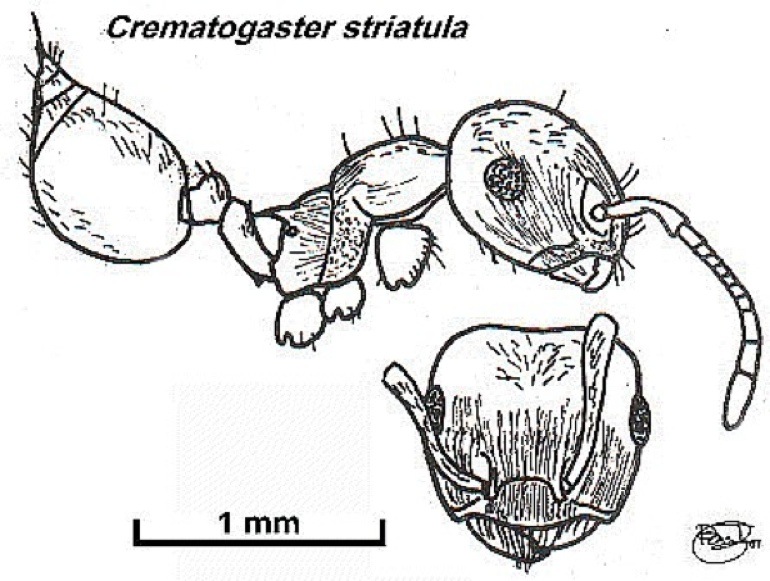Crematogaster (Sphaerocrema) striatula Emery
  Type location Ivory Coast
(Cremastogaster striatulus n. sp., Emery, 1892c: liii, worker;
Emery,
1899e: 482, queen) collected at Assinie, by Ch. Alluaud - see below Type location Ivory Coast
(Cremastogaster striatulus n. sp., Emery, 1892c: liii, worker;
Emery,
1899e: 482, queen) collected at Assinie, by Ch. Alluaud - see below
junior synonyms (here)
benitensis
(Cremastogaster striatula Em.
var. benitensis nov., Santschi, 1910c: 374, worker) from Equatorial
[Spanish] Guinea,
collected at River Benito, by de Brazza (location wrongly given as
Congo by Bolton, 1995) - no images on Antweb (August 2016)
obstinata (Cremastogaster
striatula Em. v. obstinata
n. var., Santschi, 1911g:
207,
worker) from Congo, collected at Gomba, by A. Weiss - see http://www.antweb.org/specimenImages.do?code=casent0912818
horatii
(Crematogaster (Sphaerocrema)
striatula Em. v. horatii
n. v., Santschi, 1937a: 55, worker) from Kenya, T H E Jackson - see http://www.antweb.org/specimenImages.do?code=casent0912816
omega (Crematogaster
(Sphaerocrema) striatula Em. stirps obstinata Sants. var. omega n. var., Santschi, 1926b:
224; Crem. (Sphaer.) striatula
Em. v. omega Santschi,
1935a: 259, worker) from Zaïre, Mogende, Dr Schouteden - see http://www.antweb.org/specimenImages.do?code=casent0912819
(see Bolton, 1995)  . .
|
Wheeler (1922) had numerous other records including Sierra
Leone, Ghana (Aburi, F. Silvestri), Cameroun (Douala,
von Rothkirch). It was also found inhabiting the hollow twigs of Barteria
fistulosa (Bequaert, 1922, p438-9).
Nests in dead wood on trees. Found throughout West
Africa (Strickland, 1951a). Donisthorpe (1945a, b) wrote of it as
a tropical West African species, with the typical form known from Sierra
Leone, etc., and varieties in the French Congo, Ivory Coast, etc.
He recorded findings all with Coccidae as follows - H.E. Box had
collected specimens from Ivory Coast, at Cibengouron (or
Abengourou?) (18.v.1944); with Pseudococccus species on
swollen shoot infected cocoa; with a Pseudococcus on a liana
vine at Bansa, Ghana (2.v.1944) and from a sapling in primary
forest at Bunsu (1.i.1945) and, also from cocoa at Bawdua, near Kade
(by K.O. Darko, 2.xii.1944), and Nkawkaw (J.Paine, 23.xi.1944); at
Lekleki, Dafo, and Bame Pass, Togo (2-4.xi.1944) on coffee and
cocoa.
In Ghana it is regarded as a common dominant.
Leston
(1973) regarded it as the most frequent dominant, especially in heavily
shaded farms with abundant dead wood, and important as a tender of
coccids, and also on dense secondary forest. Evans (1973), who had
worked closely with Leston, described its role as a vector of Phytophthora
pod rot of cocoa, and added that it was a common cocoa
ant dominating substantial areas under suitable conditions. At CRIG it
was the commonest of the subgenus, found in 778 of 3,766 arboreal
samples (Strickland, 1948, 1951a), and occurring on numerous forest
trees, plus kola and mango. Room (1971) used as it one of his selected
species for the 30 dominated trees, and found it on 5 other trees. He
does, however, note that it was far easier to find in the Tafo area
than elsewhere. Room also reported its occurrence on cocoa mistletoe -
being fourth most abundant insect, with 3,442 workers, from 32 of 630
samples of the mistletoe/cocoa junction (ranked 25th) (Room, 1972a, b,
1975). Majer found it in 36.8% of his 144 pkd samples at Kade, with
3500-5000 workers per sample (1975, 1976a, b, c). At CRIG in 1979-76,
however, Bigger (1981a, 1993b) found it only as an immigrant forager on
the ground of his study block of Amazon cocoa (this had been the block,
the Amelonado cocoa, used for much of Strickland's work). Bigger
(1981a) tabulated a number of surveys in Ghana and the occurrence was
quite variable at CRIG, from 2.4-41%. It was described as widespread by
Belshaw & Bolton (1994b), who found it, as a 'tourist', in leaf
litter samples at thirteen locations in the semi-deciduous forest zone.
In contrast it appears to be quite rare on cocoa in Nigeria,
where it has been found nesting in old dry cherelles. Also found on
native shrubs and trees, plus on 17-20% of both coffee and kola, and on
oil palm (Taylor, 1977). However, earlier from CRIN, found on >10%
of cocoa in pkd collections from two cocoa blocks, W13/2 and W18/1
(Booker 1968).
From Ivory Coast, there is a description of
larval stages by Delage-Darchen (1978).
|
 Nigeria specimens (Taylor, 1979: 33). WORKER.
TL
variable 3.05-3.42 mm; largest HL 0.86, HW 0.87, SL 0.70, PW 0.50 Nigeria specimens (Taylor, 1979: 33). WORKER.
TL
variable 3.05-3.42 mm; largest HL 0.86, HW 0.87, SL 0.70, PW 0.50
Colour very dark, red-brown to black, tarsi and antennal funiculi
yellow; shiny. Head finely striate. Alitrunk striated on dorsum and
laterally, faint on lateral pronotum. Lateral mesonotum spiculate.
Pilosity sparse, erect hairs moderately abundant. Profile of pro- and
mesonotum flat, mesonotum with a slight carina, propodeum on a lower
level. Propodeal spines long, acute and slightly down curved. Dorsal
surface of petiole smooth and flat, subpetiolar spine acute triangular.
|